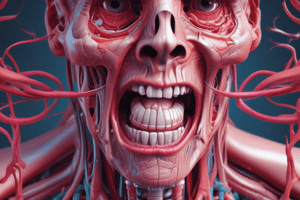Podcast
Questions and Answers
What is the primary action of the geniohyoid muscle?
What is the primary action of the geniohyoid muscle?
- Widen the oral cavity
- Shortens the tongue
- Depresses the hyoid bone
- Elevates the hyoid bone (correct)
Which structure is included in the features of the floor of the mouth?
Which structure is included in the features of the floor of the mouth?
- Tonsillar fossa
- Lingual frenum (correct)
- Uvula
- Palatopharyngeal arch
Which nerve is primarily responsible for sensory innervation of the hard palate?
Which nerve is primarily responsible for sensory innervation of the hard palate?
- Mandibular nerve
- Greater palatine nerve (correct)
- Lesser palatine nerve
- Maxillary nerve
Where does the geniohyoid muscle originate?
Where does the geniohyoid muscle originate?
Which artery supplies the greater palatine nerve?
Which artery supplies the greater palatine nerve?
What feature of the soft palate includes the palatoglossal arch?
What feature of the soft palate includes the palatoglossal arch?
Which duct is associated with the submandibular salivary glands?
Which duct is associated with the submandibular salivary glands?
Which anatomical feature is NOT found in the hard palate?
Which anatomical feature is NOT found in the hard palate?
What is the color appearance of the floor of the mouth?
What is the color appearance of the floor of the mouth?
Which characteristic best describes the hard palate?
Which characteristic best describes the hard palate?
The mylohyoid muscle has which of the following actions?
The mylohyoid muscle has which of the following actions?
Which muscle originates from the superior border of the greater cornu of the hyoid bone?
Which muscle originates from the superior border of the greater cornu of the hyoid bone?
What is a key feature of the soft palate?
What is a key feature of the soft palate?
Which condition describes the compressibility of the floor of the mouth?
Which condition describes the compressibility of the floor of the mouth?
Where do the fibers of the mylohyoid muscle insert?
Where do the fibers of the mylohyoid muscle insert?
In the context of the floor of the mouth, the term 'vascular blue' refers to which aspect?
In the context of the floor of the mouth, the term 'vascular blue' refers to which aspect?
What action does the hyoglossus muscle perform?
What action does the hyoglossus muscle perform?
Flashcards
Floor of the mouth
Floor of the mouth
The underside of the tongue, visible when the mouth is open.
Hard palate
Hard palate
The bony roof of the mouth, located behind the teeth.
Soft palate
Soft palate
The soft, fleshy part of the roof of the mouth located at the back of the hard palate.
Mylohyoid muscle
Mylohyoid muscle
Signup and view all the flashcards
Elevates the floor of mouth & hyoid bone
Elevates the floor of mouth & hyoid bone
Signup and view all the flashcards
Depresses the mandible
Depresses the mandible
Signup and view all the flashcards
Hyoglossus muscle
Hyoglossus muscle
Signup and view all the flashcards
Depresses and retracts the tongue
Depresses and retracts the tongue
Signup and view all the flashcards
Pulls down the sides of the tongue
Pulls down the sides of the tongue
Signup and view all the flashcards
Geniohyoid Muscle
Geniohyoid Muscle
Signup and view all the flashcards
Lingual Frenum
Lingual Frenum
Signup and view all the flashcards
Sublingual Papillae
Sublingual Papillae
Signup and view all the flashcards
Mandibular Tori
Mandibular Tori
Signup and view all the flashcards
Uvula
Uvula
Signup and view all the flashcards
Palate Nerve Innervation
Palate Nerve Innervation
Signup and view all the flashcards
Study Notes
Floor of the Mouth Clinical Appearance
- Color: Reddish-pink, with vascular blue hues in vein areas.
- Texture: Shiny and moist, compressible.
Palate Clinical Appearance
- Hard Palate:
- Color: Pink.
- Texture: Immobile, firm, with a slightly more cushioned feeling laterally and firmer medially.
- Soft Palate:
- Color: Deeper pink, can be slightly yellowish.
- Texture: Moist, compressible, and elastic.
Floor of the Mouth Muscles
- Mylohyoid:
- Origin: Mylohyoid line of mandible.
- Insertion: Anterior surface of hyoid bone.
- Action: Forms floor of oral cavity, elevates floor of mouth and hyoid, assists in depressing mandible.
- Hyoglossus:
- Origin: Superior border of hyoid greater cornu.
- Insertion: Lateral borders of tongue.
- Action: Depresses and retracts tongue, pulls lateral edges down on floor of mouth.
- Geniohyoid:
- Origin: Inferior genial tubercle (mental spine) of mandible.
- Insertion: Body of hyoid bone.
- Action: Elevates hyoid, shortens floor of mouth, widens pharynx.
Floor of the Mouth Key Features
- Lingual frenum
- Sublingual papillae (and sublingual folds)
- Mandibular tori
- Ventral surface of tongue
- Wharton's duct (submandibular salivary glands)
- Bartholin's duct and Rivinus ducts (sublingual salivary glands)
- Minor salivary glands of the floor of the mouth
Palate Key Features
- Hard Palate:
- Medial
- Anterior
- Posterior
- Lateral
- Soft Palate:
- Uvula
- Pillars of Fauces (palatoglossal and palatopharyngeal arches)
- Tonsillar fossa
- Pterygo-mandibular fold
Nerve Innervation and Blood Supply
- Floor of the Mouth: Innervation and blood supply details are not provided.
- Hard Palate: Sensory innervation by branches of maxillary nerve (trigeminal V), with greater palatine and nasopalatine nerves and greater palatine artery.
- Soft Palate: Sensory innervation by lesser palatine nerve, with lesser palatine arteries.
Studying That Suits You
Use AI to generate personalized quizzes and flashcards to suit your learning preferences.
Description
This quiz covers the clinical appearance and anatomical features of the floor of the mouth and palate. It includes details on muscle origins, insertions, and actions relevant to the oral cavity. Enhance your understanding of oral anatomy and its implications in clinical practice.




